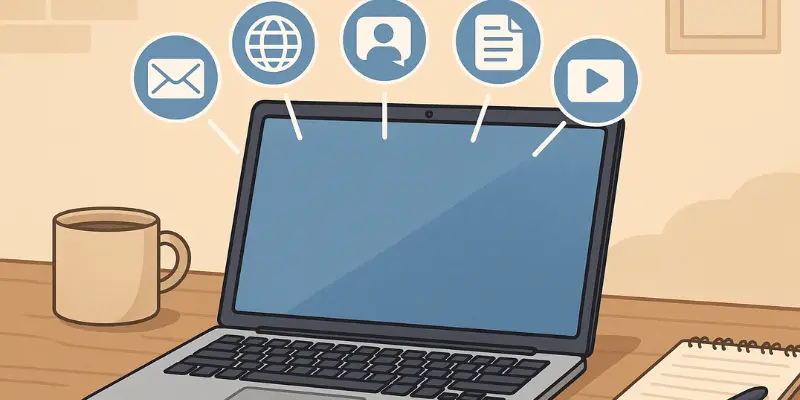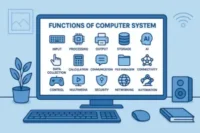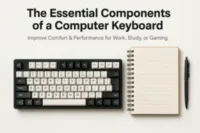Laptop Functions Guide: Everything Students Need to Know
Published: 9 Aug 2025
I still remember the day I lugged my old desktop to a tiny café on a stormy afternoon—cables everywhere, the hum of the fan masking the rain tapping against the window. It hit me then: there had to be a better way. That’s when I discovered the freedom of a laptop—a compact, all-in-one portal to work, play, and creation. With that one portable device, my desk followed me to school, a business meeting, or even into bed on lazy mornings.
That sense of mobility, connectivity, and versatility—all packed into a sleek shell—is what defines the function of a laptop. And in this post, we’ll explore those functions with real-world data to back them up and help you understand just how essential they’ve become.

1. Core Computing Functions
Data Processing Operations
Laptops perform complex calculations through their central processing unit, handling everything from simple text editing to advanced mathematical computations. The system processes millions of instructions per second, managing multiple applications simultaneously while maintaining system stability.
Operating System Management
The laptop’s operating system coordinates all hardware components, providing a user-friendly interface for interaction. It manages system resources, schedules tasks efficiently, and ensures smooth communication between software applications and hardware components.
2. Function of Core in Laptop
The function of core in laptop determines the device’s ability to handle multiple tasks simultaneously. Modern laptops feature multi-core processors that divide workload efficiently:
Single-Core Operations: Handle basic tasks like web browsing and document editing with adequate performance for simple computing needs.
Multi-Core Advantages: Dual-core and quad-core processors excel at multitasking, allowing users to run video calls while editing documents or streaming music simultaneously.
Performance Impact: More cores translate to better performance in demanding applications like video editing, gaming, and software development, making the laptop more versatile for professional use.
3. Function of RAM in Laptop
The function of RAM in laptop involves temporary data storage that directly impacts system performance and user experience:
Active Program Storage: RAM holds currently running applications in memory, allowing instant access and smooth switching between programs without delays.
Multitasking Support: Higher RAM capacity enables running multiple applications simultaneously – 8GB RAM supports moderate multitasking while 16GB handles intensive workflows with ease.
System Responsiveness: Adequate RAM prevents system slowdowns, eliminates lag during application launches, and ensures smooth performance during demanding tasks like video editing or data analysis.
Speed Enhancement: More RAM reduces reliance on slower storage devices, keeping frequently accessed data readily available for immediate processing.
4. Function of SSD in Laptop
The function of SSD in laptop revolutionizes data storage with significant performance improvements over traditional hard drives:
Faster Data Access: SSDs provide lightning-fast boot times, typically starting up in 10-15 seconds compared to minutes with traditional drives, dramatically improving productivity.
Enhanced Durability: Without moving parts, SSDs resist physical shock and vibration, making them ideal for portable devices that face daily handling and transportation.
Power Efficiency: SSDs consume less battery power, extending laptop usage time by 30-60 minutes on average, crucial for mobile computing needs.
Silent Operation: Complete absence of mechanical noise creates a quieter computing environment, essential for library study sessions and office meetings.
Performance Benefits: File transfers, application loading, and system updates complete significantly faster, reducing waiting time and increasing workflow efficiency.
4.Input and Output Functions
User Interaction Systems
Laptops feature integrated input devices designed for portable use. The keyboard provides tactile feedback for accurate typing, while the trackpad offers precise cursor control with multi-touch gesture support for navigation efficiency.
Display and Audio Output
The integrated display delivers visual information with adjustable brightness and color settings. Built-in speakers provide audio output for multimedia content, while headphone jacks enable private listening during study or entertainment sessions.
5. Function of Laptop for Students
Research and Information Access: Laptops provide instant access to online libraries, academic databases, and educational resources, eliminating the need for physical library visits for most research tasks.
Note-Taking Efficiency: Digital note-taking allows students to organize, search, and share notes easily, with the ability to include multimedia elements like images and audio recordings from lectures.
Assignment Completion: Word processing, spreadsheet analysis, and presentation creation tools enable students to complete assignments professionally with formatting, citations, and collaborative editing features.
Online Learning Platform Access: Students can attend virtual classes, submit assignments digitally, and participate in online discussions, essential for modern educational requirements.
6. Communication and Connectivity Functions
Network Access and Internet Functions
Laptops connect to Wi-Fi networks for internet access, enabling web browsing, email communication, and cloud service integration. Bluetooth connectivity supports wireless peripherals like headphones, mice, and speakers.
Professional Communication
Video conferencing capabilities support remote meetings, virtual interviews, and online presentations. Email clients manage professional correspondence while instant messaging facilitates quick communication with colleagues and classmates.
7. Storage and Data Management Functions
File Organization
Laptops organize documents, photos, and media files in structured folder systems. Search functions help locate specific files quickly, while backup systems protect important data from loss.
External Storage Support
USB ports accommodate external drives for additional storage or file transfer. SD card readers support camera memory cards for photo and video import directly to the laptop.
8. Power Management Functions
Battery Operation
Laptops operate independently from wall power through rechargeable batteries, typically providing 4-8 hours of usage depending on tasks and power settings. Smart charging systems protect battery health and extend lifespan.
Energy Efficiency
Power management features automatically adjust screen brightness, processor speed, and component activity to conserve battery life. Sleep and hibernation modes preserve work while minimizing power consumption during breaks.
9. Specialized Functions by Laptop Type
Gaming Laptops
High-performance graphics processing enables smooth gaming experiences with detailed visuals and fast frame rates. Advanced cooling systems prevent overheating during intensive gaming sessions.
Business Laptops
Enhanced security features protect sensitive corporate data. Professional software compatibility ensures seamless integration with workplace systems and enterprise applications.
Student Laptops
Balanced performance and affordability meet academic needs without unnecessary features. Long battery life supports full-day campus use without frequent charging requirements.
Conclusion
Laptops serve as versatile computing devices that combine portability with powerful functionality. The function of core in laptop determines processing speed, while function of RAM in laptop ensures smooth multitasking, and function of SSD in laptop provides fast, reliable storage. For students, laptops offer essential tools for research, note-taking, and assignment completion.
Understanding laptop basic knowledge helps users make informed decisions about their computing needs. Whether for academic work, professional tasks, or entertainment, laptops continue evolving with new technologies like AI integration and advanced connectivity options. The combination of essential components working together makes laptops indispensable tools in modern digital life.
The main function of a laptop is to provide portable computing for work, study, and entertainment. It processes data, runs applications, stores files, and connects to the internet while being lightweight and battery-powered for mobility.
Laptops essentially combine desktop computer power with portability, making them essential for modern digital tasks anywhere.

- Be Respectful
- Stay Relevant
- Stay Positive
- True Feedback
- Encourage Discussion
- Avoid Spamming
- No Fake News
- Don't Copy-Paste
- No Personal Attacks

- Be Respectful
- Stay Relevant
- Stay Positive
- True Feedback
- Encourage Discussion
- Avoid Spamming
- No Fake News
- Don't Copy-Paste
- No Personal Attacks





